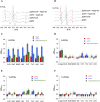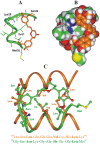Investigating the Neuroprotective Effects of Turmeric Extract: Structural Interactions of β-Amyloid Peptide with Single Curcuminoids
- PMID: 28004737
- PMCID: PMC5177957
- DOI: 10.1038/srep38846
Investigating the Neuroprotective Effects of Turmeric Extract: Structural Interactions of β-Amyloid Peptide with Single Curcuminoids
Abstract
A broad biophysical analysis was performed to investigate the molecular basis of the neuroprotective action of Curcuma longa extracts in Alzheimer's disease. By combining circular dichroism and electron paramagnetic resonance experiments with molecular modeling calculations, the minor components of Curcuma longa extracts, such as demethoxycurcumin (2, DMC), bisdemethoxycurcumin (3, BDMC) and cyclocurcumin (4, CYC), were analyzed in a membrane environment mimicking the phospholipid bilayer. Our study provides the first evidence on the relative role of single curcuminoids interacting with Aβ-peptide. When the CYC and curcumin metabolite tetrahydrocurcumin (5, THC) were inserted into an anionic lipid solution, a significant modification of the Aβ CD curves was detected. These data were implemented by EPR experiments, demonstrating that CYC reaches the inner part of the bilayer, while the other curcuminoids are localized close to the membrane interface. Computational studies provided a model for the curcuminoid-Aβ interaction, highlighting the importance of a constrained "semi-folded" conformation to interact with Aβ analogously to the pattern observed in α-helical coiled-coil peptide structures. This combined approach led to a better understanding of the intriguing in vitro and in vivo activity of curcuminoids as anti-Alzheimer agents, paving a new path for the rational design of optimized druggable analogues.
Figures






Similar articles
-
Comparison of antioxidant, anticholinesterase, and antidiabetic activities of three curcuminoids isolated from Curcuma longa L.Nat Prod Res. 2017 Dec;31(24):2914-2917. doi: 10.1080/14786419.2017.1299727. Epub 2017 Mar 13. Nat Prod Res. 2017. PMID: 28287280
-
A Structural Effect of the Antioxidant Curcuminoids on the Aβ(1-42) Amyloid Peptide.Antioxidants (Basel). 2025 Jan 5;14(1):53. doi: 10.3390/antiox14010053. Antioxidants (Basel). 2025. PMID: 39857387 Free PMC article.
-
Protective Effects of Minor Components of Curcuminoids on Hydrogen Peroxide-Treated Human HaCaT Keratinocytes.J Agric Food Chem. 2016 May 11;64(18):3598-608. doi: 10.1021/acs.jafc.6b01196. Epub 2016 Apr 28. J Agric Food Chem. 2016. PMID: 27094403
-
Therapeutic potential of turmeric in Alzheimer's disease: curcumin or curcuminoids?Phytother Res. 2014 Apr;28(4):517-25. doi: 10.1002/ptr.5030. Epub 2013 Jul 19. Phytother Res. 2014. PMID: 23873854 Review.
-
Curcuminoids: Implication for inflammation and oxidative stress in cardiovascular diseases.Phytother Res. 2019 May;33(5):1302-1317. doi: 10.1002/ptr.6324. Epub 2019 Mar 4. Phytother Res. 2019. PMID: 30834628 Review.
Cited by
-
Heat Shock Proteins and Autophagy Pathways in Neuroprotection: from Molecular Bases to Pharmacological Interventions.Int J Mol Sci. 2018 Jan 22;19(1):325. doi: 10.3390/ijms19010325. Int J Mol Sci. 2018. PMID: 29361800 Free PMC article. Review.
-
Monitoring the Conformational Changes of the Aβ(25-35) Peptide in SDS Micelles: A Matter of Time.Int J Mol Sci. 2023 Jan 4;24(2):971. doi: 10.3390/ijms24020971. Int J Mol Sci. 2023. PMID: 36674488 Free PMC article.
-
Cause and consequence of Aβ - Lipid interactions in Alzheimer disease pathogenesis.Biochim Biophys Acta Biomembr. 2018 Sep;1860(9):1652-1662. doi: 10.1016/j.bbamem.2018.03.004. Epub 2018 Mar 9. Biochim Biophys Acta Biomembr. 2018. PMID: 29526709 Free PMC article. Review.
-
Curcumin in Health and Diseases: Alzheimer's Disease and Curcumin Analogues, Derivatives, and Hybrids.Int J Mol Sci. 2020 Mar 13;21(6):1975. doi: 10.3390/ijms21061975. Int J Mol Sci. 2020. PMID: 32183162 Free PMC article. Review.
-
Prilling as an Effective Tool for Manufacturing Submicrometric and Nanometric PLGA Particles for Controlled Drug Delivery to Wounds: Stability and Curcumin Release.Pharmaceutics. 2025 Jan 17;17(1):129. doi: 10.3390/pharmaceutics17010129. Pharmaceutics. 2025. PMID: 39861775 Free PMC article.
References
-
- Selkoe D. J. Alzheimer’s disease: Genes, proteins, and therapy. Physiol Rev 81, 741–766 (2001). - PubMed
-
- Walsh D. M. & Selkoe D. J. Deciphering the molecular basis of memory failure in Alzheimer’s disease. Neuron 44, 181–193 (2004). - PubMed
-
- Sipe J. D. & Cohen A. S. Review: History of the amyloid fibril. J Struct Biol 130, 88–98 (2000). - PubMed
-
- Hardy J. & Selkoe D. J. Medicine - The amyloid hypothesis of Alzheimer’s disease: Progress and problems on the road to therapeutics. Science 297, 353–356 (2002). - PubMed
Publication types
MeSH terms
Substances
LinkOut - more resources
Full Text Sources
Other Literature Sources

